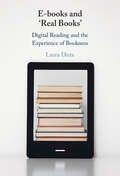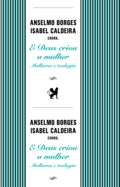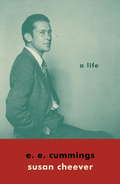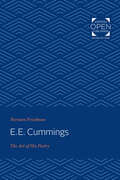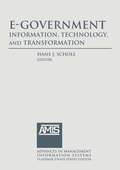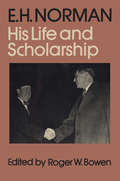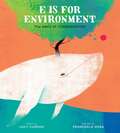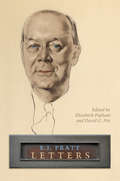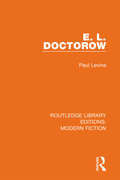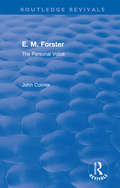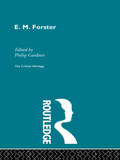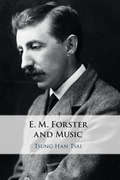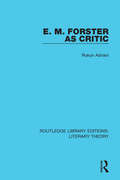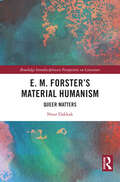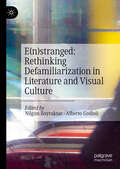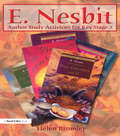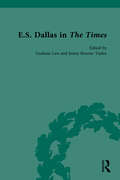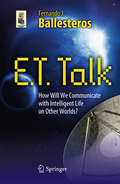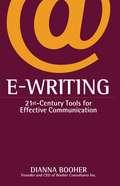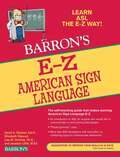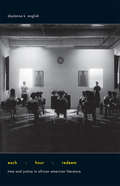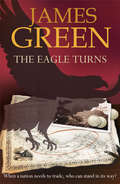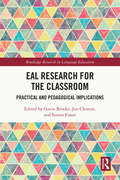- Table View
- List View
E-books and ‘Real Books’: Digital Reading and the Experience of Bookness
by Laura DietzOn any given day, millions of people will read e-books. Yet many of us will do so while holding them apart from 'real books'. The fact that a book can be worthy – of our time, money, respect, even love – without being 'real' is a fascinating paradox of twenty-first century reading. Drawing on original data from a longitudinal study, Laura Dietz investigates how movement between conceptions of e-books as ersatz, digital proxy, and incomplete books serves readers in unexpected ways. The cultural value of e-books remains an area of intense debate in publishing studies. Exploring the legitimacy of e-books in terms of their 'realness' and 'bookness', Dietz enriches our understanding of what e-books are, while also opening up new ways of thinking about how we imagine, how we use, and what we want from books of every kind. This title is also available as Open Access on Cambridge Core.
E Deus Criou a Mulher: Mulheres e Teologia
by Isabel Caldeira Anselmo BorgesA teologia feminista surge da rebelião das mulheres contra o seu apagamento e silenciamento pelas religiões dominadas pela visão patriarcal. Daí a importância das suas interrogações, dos textos, das suas revisões da história, da sua reformulação das crenças e das práticas religiosas. Mas, como nos diz Juan José Tamayo, não esqueçamos que a causa da emancipação e da igualdade (não clonada) das mulheres não é só assunto de mulheres, mas sim de todos os cidadãos e cidadãs comprometidos na luta contra a discriminação sexual.
E. E. Cummings
by Susan CheeverFrom the author of American Bloomsbury ("Beguiling" --Publishers Weekly), Louisa May Alcott ("Fascinating . . . Another splendid piece of work with hidden depths by Susan Cheever"--Michael Korda), and Home Before Dark ("Moving and brilliantly restrained"--The New York Times Book Review), a major reassessment of the life and work of the novelist, painter, and playwright considered to be one of America's preeminent twentieth-century poets, our generation's beloved heretic. At the time of his death in 1962, at age sixty-eight, he was, after Robert Frost, the most widely read poet in the United States. E. E. Cummings was and remains controversial. He has been called "a master" (Malcolm Cowley); "hideous" (Edmund Wilson). James Dickey called him a "daringly original poet with more vitality and more sheer uncompromising talent than any other living American writer." In Susan Cheever's rich, illuminating biography we see Cummings's idyllic childhood years in a mythic part of Cambridge, Massachusetts (the Cummings house was within calling distance of Harvard professor William James, who first introduced Cummings's parents); his Calvinist father--distinguished Harvard professor and sternly religious minister of the Cambridge Congregational Church; his mother--loving, attentive, a source of encouragement, the aristocrat of the family, from Unitarian writers, judges, and adventurers. We see Cummings--slight, agile, playful, a product of a nineteenth-century New England childhood, bred to be flinty and determined; his love of nature ("here my enormous smallness entered Her illimitable being"); his sense of fun, laughter, mimicry; his desire from the get-go to stand conventional wisdom on its head, which he himself would often do, literally, to amuse. At Harvard, he roomed with John Dos Passos; befriended Lincoln Kirstein; read Latin, Greek, and French; earned two degrees; discovered alcohol, fast cars, and burlesque at the Old Howard Theater; and raged against the school's conservative, exclusionary upper-class rule by A. Lawrence Lowell. In Cheever's book we see that beneath Cummings's blissful, golden childhood the strains of sadness and rage were already at play. He grew into a dark young man and set out on a lifelong course of rebellion against conventional authority and the critical establishment, devouring the poetry of Ezra Pound, whose radical verses pushed Cummings away from the politeness of the traditional nature poem toward a more adventurous, sexually conscious form. We see that Cummings's self-imposed exile from Cambridge--a town he'd come to hate for its intellectualism, Puritan uptightness ("the Cambridge ladies," he wrote, "who live in furnished souls"), racism, and self-righteous xenophobia--seemed necessary for him as a man and a poet. Headstrong and cavalier, he volunteered as an ambulance driver in World War I, working alongside Hemingway, Joyce, and Ford Madox Ford . . . his ongoing stand against the imprisonment of his soul taking a literal turn when he was held in a makeshift prison for "undesirables and spies," an experience that became the basis for his novel, The Enormous Room, of which F. Scott Fitzgerald wrote: "Of all the work by young men since 1920--one book survives." We follow Cummings as he permanently flees to Greenwich Village to be among other modernist poets of the day--Marianne Moore, Hart Crane, Dylan Thomas--and we see the development of both the poet and his work against the backdrop of modernism and through the influences of his contemporaries: Stein, Amy Lowell, Joyce, and Pound.Cheever's fascinating book gives us the evolution of an artist whose writing was at the forefront of what was new and daring and bold in an America in transition.(With 28 pages of black-and-white images.)From the Hardcover edition.
E. E. Cummings: The Art of His Poetry
by Norman FriedmanOriginally published in 1960. In E. E. Cummings: The Art of His Poetry, Norman Friedman argues that critics who have focused on what Cummings's poetry lacks have failed to judge Cummings on his strengths. Friedman identifies a main strength of Cummings as his being a "sensual mystic." The book unpacks Cummings's subject matter, devices, and symbolism, ultimately helping readers develop a deeper understanding and appreciation of Cummings's work.
E-Government: Information, Technology, and Transformation (Advances In Management Information Systems Ser.)
by Hans J SchnollThis book presents a citizen-centric perspective of the dual components of e-government and e-governance. E-government> refers to the practice of online public reporting by government to citizens, and to service delivery via the Internet. E-governance represents the initiatives for citizens to participate and provide their opinion on government websites. This volume in the Public Solutions Handbook Series focuses on various e-government initiatives from the United States and abroad, and will help guide public service practitioners in their transformation to e-government. The book provides important recommendations and suggestions oriented towards practitioners, and makes a significant contribution to e-government by showcasing successful models and highlighting the lessons learned in the implementation processes. Chapter coverage includes: Online fiscal transparency Performance reporting Improving citizen participation Privacy issues in e-governance Internet voting E-government at the local level
E.H. Norman: His Life and Scholarship
by Roger W. BowenThe ashes of Herbert Norman now lie in the British cemetery at Rome, near those of Shelley and Keats. His distinguished life and tragic death, in April 1957, are recalled and examined in this book by scholars and diplomats from four countries--the United States, Japan, Canada, and Britain.Born in rural Japan the son of a Canadian missionary, Herbert Norman studied at the University of Toronto and went in 1933 to Cambridge University on a scholarship. There, in that intellectual hothouse where it seemed one had to choose politically between communism and fascism as the future of the West, he joined the Communist party--a move that became a crime later in the fixed and 'sightless' (as the editor describes them) eyes of his American accusers.According to Edwin Reischauer, later the US ambassador to Japan, 'his harassment by the American government was unforgiveable.' His suicide in Cairo, while Canadian ambassador to Nasser's Egypt during and after the delicate times of the Suez Crisis and the establishment of the UN peace-keeping force, raised broader questions for Lester Pearson--'the right, to say nothing of the propriety, of a foreign government to intervene' in Canadian affairs.Norman was also a renowned historian of Japan. His Japan's Emergence as a Modern State has been called a classic, and between 1946 and 1950, as head of the Canadian Liaison Mission in Tokyo, he was a close and friendly adviser to General Douglas MacArthur in his efforts to reconstitute that country. Both this work and his writings on Japan were sympathetic to human freedoms and democracy, and they too became controversial as sides congealed in the Cold War. Five papers in this book assess Norman's scholarly work in the historiography of Japan.Four lecture papers by Norman (three previously unpublished) are included which show his change from 'a doctrinaire Marxist to a Jeffersonian Liberal,' a change historians can accept as fact whereas intelligence agencies could not and remade Norman into a communist. He was not a spy, the editor concludes, and should be remembered as the hero of a modern tragedy.
E Is for Environment: The ABCs of Conservation
by Lucy CurranA is for Atmosphere, B is for Biodiversity, C is for Conservation, and so on in this delightful concept book that teaches young readers the ABCs of the natural world around us (and how to protect it).From jungles to recycling to wildlife preserves, each letter of the alphabet is represented by a word and image that reflects everything from the rainforest to the savannah to the depths of the ocean, as well as animal life across the continents. Readers will be inspired to join the movement to conserve species and find out how they can make a difference (because you're never too young to start saving the world!).
E Is for Evergreen: A Washington Alphabet
by Roland Smith Marie SmithTraverse through the hemlocks, ferry between the islands, or take in the scent of fresh picked apples with authors Marie and Roland Smith in E is for Evergreen: A Washington Alphabet. This children's pictorial provides a fascinating journey through our 42nd state--the only state to be named after a president. Beginning readers will enjoy the simple rhymes and vivid illustrations while older children discover many detailed facts in the sidebar expository. Washington natives and visitors alike will enjoy learning why the Peace Arch spans two countries and what role folklore tells us Paul Bunyan played. Find out what began in Spokane in 1910 and which important city was once known as Black Bear Place.
E.J. Pratt: Letters
by David G. Pitt E.J. Pratt Library Elizabeth A. PophamThis edition of E.J. Pratt’s letters is the final volume in the Collected Works series. Because of Pratt’s role in the making of Canadian culture between and after the World Wars, his correspondence highlights key moments in our cultural history and provides a view of the enterprise from its very centre. The letters take us into his "workshop," illuminating the research behind his distinctive documentary long poems and the social nature of his creative production. They also reveal the complex network of writers, critics, artists and political figures of which Pratt was a part, the evolution of the Canadian book trade from the 1920s through to the early 1960s, and the emergence of radio (and specifically, of the Canadian Broadcasting Corporation) as a tool for forging national identity. Pratt's correspondence both confirms the public persona of one of Canada’s first literary celebrities and provides glimpses of the private character behind the mask.
E. L. Doctorow (Routledge Library Editions: Modern Fiction #20)
by Paul LevineDuring his lifetime E. L. Doctorow was a remarkable phenomenon among contemporary American novelists. He was a serious writer who was popular, a political writer who was a stylist, an original writer who was highly eclectic and an historical writer who invented the past. In this study, originally published in 1985, Paul Levine follows Doctorow’s progress as a novelist and traces the development of certain themes that recur in his work including the relationships between history and imagination, between high and popular culture and between political content and radical style. He also examines Doctorow’s notion of the writer as witness and actor and of writing as a subversive activity, two concerns which link him with important writers in Europe and Latin America. The book should provide a valuable and comprehensive coverage of his work to date, including the films of Ragtime and The Book of Daniel.
E. M. Forster: The Personal Voice (Routledge Revivals)
by John ColmerOriginally published in 1975, E. M. Forster: The Personal Voice draws on information about the life and works of E. M. Forster that came to light following his death in 1970. Exploring in particular the publication of Maurice in 1971, The Life to Come in 1972, and the Forster papers in King's College Library, Cambridge, this volume is an extensive study of E. M. Forster. It provides a comprehensive and detailed overview of Forster's work, his intellectual and literary background, his personality, and the reception of his work. E. M. Forster: The Personal Voice places Forster's works in their social and cultural context and provides an excellent insight into his development as a writer.
E.M. Forster
by E. M. ForsterThis set comprises 40 volumes covering 19th and 20th century European and American authors. These volumes will be available as a complete set, mini boxed sets (by theme) or as individual volumes. This second set compliments the first 68 volume set of Critical Heritage published by Routledge in October 1995.
E. M. Forster and Music
by Tsung-Han TsaiThis book examines the political resonances of E. M. Forster's representations of music, offering readings of canonical and overlooked works. It reveals music's crucial role in his writing and draws attention to a previously unacknowledged eclecticism and complexity in Forster's ideological outlook. Examining unobtrusive musical allusions in a variety of Forster's writings, this book demonstrates how music provided Forster with a means of reflecting on race and epistemology, material culture and colonialism, literary heritage and national character, hero-worship and war, and gender and professionalism. It unveils how Forster's musical representations are mediated through a matrix of ideas and debates of his time, such as those about evolution, empire, Britain's relationship with the Continent, the rise of fascism, and the emergence of musicology as an academic discipline.
E. M. Forster as Critic (Routledge Library Editions: Literary Theory #3)
by Rukun AdvaniThis title, first published in 1984, is a study of E. M. Forster as a liberal-humanist thinker and socio-literary critic. Advani discusses Forster’s ideas on man, society, politics, religion, art, aesthetics, fiction and literary criticism. The author examines why Forster was impelled from fiction towards socio-literary criticism and propaganda for art within the political and cultural context of post-Great War Britain. The book argues for Forster’s continuing importance as much more than a skilful novelist. It will be of interest to students of English cultural history, literary theory and criticism, and the work of E. M. Forster.
E. M. Forster’s Material Humanism: Queer Matters (Routledge Interdisciplinary Perspectives on Literature)
by Nour DakkakThrough attending to the nonhuman, E. M. Forster’s Material Humanism: Queer Matters places Forster’s fiction in conversation with contemporary debates concerned with the intersection of neomaterialism, environmental humanities and queer ecology. The book revisits Forster’s liberal humanism from a materialist perspective by focusing on humans’ embodied activities in artificial and natural environments. By examining the everyday embodied experiences of characters, the book thus brings to the fore insignificant and sometimes overlooked aspects in Forster’s fiction. It also places importance on the texts’ treatment of queer intimacy as an embodied experience that can transcend sexual desire. The book acknowledges nonhuman agency as central to our understanding of queerness in Forster’s texts and studies the representation of formless matters such as dust as a way through which Forster’s ecological concerns arise by linking the fate of oppressed humans with oppressed nonhuman others.
E(n)stranged: Rethinking Defamiliarization in Literature and Visual Culture
by Nilgun Bayraktar Alberto GodioliVariously translated as “estrangement,” “enstrangement” or “defamiliarization,” Viktor Shklovsky’s concept of ostranenie is more relevant than ever. This collection offers new insights into the theories and practices of ostranenie across various languages and cultures, with a particular focus on the 20th and 21st centuries. Our current era is marked by a dramatic redefinition of the normal and the strange, the familiar and the weird. The rise of far-right populism has increasingly normalized xenophobic and nativist stances previously confined to the fringes of the political spectrum. Additionally, the climate crisis has led to the ongoing renegotiation of the concepts of normalcy and emergency amid widespread efforts to adapt to the “new (ab)normal.” Exploring defamiliarization provides a unique perspective to comprehend and question these processes and their profound cultural implications. Focusing on ostranenie also offers valuable insights into how aesthetic forms serve a political function. Defamiliarization can take on various forms, including retro-futuristic dystopias, stylized films, and darkly humorous cartoons and memes. It can be an effective tool for political activation that relies on formal innovation rather than superficial emotional engagement. This collection brings together the work of a group of scholars examining defamiliarization across different media. It explores questions such as: How can we differentiate between various forms of defamiliarization and analyze their effects on the reader/viewer? How is defamiliarization connected to the weird, the eerie, or the uncanny? As a result, the collection offers an updated theoretical framework for understanding the wide range of emergent artistic and literary practices of e(n)strangement in the current era and their significant political affordances. Chapter 6 is available open access under a Creative Commons Attribution 4.0 International License via link.springer.com
E Nesbit: Author Study Activities for Key Stage 2
by Helen BromleyThis innovative series is designed to help primary teachers plan focused sessions on the work of popular, well-loved and valued authors, both classic and contemporary. Each book contains a range of activities for use directly in the classroom, covering biographical information about the author; a review of the author's work and a summary of major themes in his/her key texts; key language features of the author; frameworks to help children analyze, evaluate and compare texts, and to develop personal opinions of authors' works; ideas for writing modeled on or developed from key texts; speaking and listening opportunities; drama and role play ideas; and references to video, CD-ROM, websites and ICT activities. Inside each book is a full-color pullout poster illustrating the work of the author, which also has a set of challenges for children on the back. First published in the 1900s, Edith Nesbit's classic stories - including tales about the Bastable family, Five Children and It, The Treasure Seekers and The Railway Children - are still very popular indeed. This book presents activities on which to build a study of E. Nesbit's work, including: developing philosophical discussions on a variety of topics; ideas for writing - both narrative and non-narrative; ways of encouraging children to analyze text through devising games for others to play; promoting research skills - including critical reflection on internet use; investigating changes in language; comparing televisual and written versions of text; and work on cross-curricular themes, including history and geography.
E.S. Dallas in The Times
by Graham Law Jenny Bourne TaylorThis volume comprises of a substantial selection of E.S. Dallas’s journalism in The Times. Although his reviews were crucial not only in forging the literary reputations of upcoming writers such as different as George Eliot and Mary Elizabeth Braddon, but also in recalibrating the response to well-established authors such as Tennyson and Dickens, Eneas Sweetland Dallas (1827-79) remains arguably the most unjustly neglected of mid-Victorian critics. Although Dallas wrote for many other periodicals, it was his reviews in The Times that had the greatest impact on both the market for books and literary culture in the mid-Victorian period. This collection brings together an anthology of his contributions, as well as a newly written introduction, a comprehensive listing of the articles he submitted to The Times, critical apparatus to contextualise the materials, and a detailed chronology, reappraising Dallas’ biography. This volume will be of great interest to students and scholars of literary history.
E.T.: The Extra Terrestrial, Star Wars: A New Hope (Readers' and Writers' Genre Workshop Ser.)
by Cynthia Swain Lucy ForteNIMAC-sourced textbook
E.T. Talk
by Fernando J. BallesterosWill it be possible to communicate with intelligent extraterrestrial life forms if we find them? How could we establish this communication, where would we begin? What does it mean to say that mathematics is a universal language? How could math be used to communicate with ETs? This book summarizes the work of SETI, the Search for Extraterrestrial Intelligence, and other search programs and considers the implications of, and concerns about, their possible success. Surely the next step after finding life elsewhere would be to try to communicate with it. The author of this book will suggest concrete ways to approach this problem. This book, published in Spanish first, tells us what scientists currently know about the origin of life and its possible presence in the rest of the universe. It also describes the various methods used today to search for life in the universe. But the major focus of the book is on communicating with ET and, using animals on Earth as an example, why we should feel encouraged that we will be able to do just that. The author even provides step by step instructions in a kind of language that could be used to converse with intelligent alien beings.
E-Writing
by BooherAre you guilty of e-mail "trigger finger"? Do you constantly "cc" people you never even see? What are today's rules for conducting business over the Internet? Now, The Elements of Style meets "the Miss Manners of memos" in the ultimate writing guide for the digital age. In an era when written communication in the workplace is more crucial than ever, at a time when many professionals all but completely eschew face-to-face dealings, E-writing is poised to become the new bible of business writing. Accessible and inviting, this Web-savvy "how-to" book promises to transform anxious e-mail hacks and mediocre memo writers into eloquent electronic scribes in no time at all. Inside, you will learn how to: combat counterproductive e-mail habits write authoritatively and persuasively, with a clear message that generates quick action handle e-mail and letter correspondence efficiently and effectively select an appropriate style for the audience you're addressing heighten your professional image, self-confidence, and career prospects. Practicing what she preaches, award-winning communicator and bestselling author Dianna Booher writes in a refreshingly straightforward style and has organized E-writing to make on-the-spot referencing a snap. Keep it handy; refer to it often -- and your online mailbox will never be the same again.
E-Z American Sign Language, 3rd Edition (Barron's E-Z Series)
by David Stewart Elizabeth Stewart Lisa DimlingA Simon & Schuster eBook. Simon & Schuster has a great book for every reader.
Each Hour Redeem: Time and Justice in African American Literature
by Daylanne K. EnglishEach Hour Redeem advances a major reinterpretation of African American literature from the late eighteenth century to the present by demonstrating how its authors are centrally concerned with racially different experiences of time. Daylanne K. English argues that, from Phillis Wheatley to Suzan-Lori Parks, African American writers have depicted distinctive forms of temporality to challenge racial injustices supported by dominant ideas of time. The first book to explore the representation of time throughout the African American literary canon, Each Hour Redeem illuminates how the pervasive and potent tropes of timekeeping provide the basis for an overarching new understanding of the tradition.Combing literary, historical, legal, and philosophical approaches, Each Hour Redeem examines a wide range of genres, including poetry, fiction, drama, slave narratives, and other forms of nonfiction. English shows that much of African American literature is characterized by &“strategic anachronism,&” the use of prior literary forms to investigate contemporary political realities, as seen in Walter Mosley&’s recent turn to hard-boiled detective fiction. By contrast, &“strategic presentism&” is exemplified in the Black Arts Movement and the Harlem Renaissance and their investment in contemporary political potentialities, for example, in Langston Hughes and Amiri Baraka&’s adaptation of the jazz of their eras for poetic form and content. Overall, the book effectively demonstrates how African American writers have employed multiple and complex conceptions of time not only to trace racial injustice but also to help construct a powerful literary tradition across the centuries.
The Eagle Turns: Agents of Independence Series (Agents Of Independence Ser. #3)
by James Green1850 and America is violently divided on the issue of slavery. When President Zachary Taylor dies, suddenly and under questionable circumstances, it is left to his Vice President, Millard Fillmore, a weaker man, to find ways to keep the North and the South apart.In New York, child of Irish immigrants, Matthew O’Hanlon is fired from his job as a newsman on the Herald but, surprisingly, finds work as Foreign Correspondent for the Associated Press in Panama City. There he is given accommodation with a Dr Couperin, his wife and beautiful daughter, Edith, but finds himself caught up with the secret agents protecting America’s commercial interests during the struggle for control of Panama’s trade routes and, as it crashes about him, realises that he has been living in a house of cards. Set against the Gold Rush and the opening up of California and the OregonTerritories, when the United States walked a narrow and dangerous line, The Eagle Turns charts the course of history as America’s Secret Services struggle to bring prosperity amid the conflict.
EAL Research for the Classroom: Practical and Pedagogical Implications (Routledge Research in Language Education)
by Gavin Brooks Jon Clenton Simon FraserWith an estimated 1.6 million English as an Additional Language (EAL) learners in the UK, and over 5 million in the USA, EAL research is urgently needed to inform practice. This edited volume investigates the multifaceted elements that shape EAL pedagogy and research in a variety of settings and research areas including linguistic ability influences on subject-specific skills, integrating learners’ home languages into classroom environments, and the importance of supporting EAL teachers in the classroom. In doing so, the contributors provide an international perspective on the emerging field of EAL research. The research-based chapters detail fundamental concerns related to EAL learner education. The text is composed of three parts: Part 1 explores the question of what is EAL and how a definition can shape policy construction; Part 2 examines the challenges EAL learners face in the classroom, including the use of first languages and the relative impact learner language proficiency has on subject-specific classes; and Part 3 investigates concerns relating to supporting EAL teachers in the classroom. The volume draws on researcher expertise from a variety of universities and institutions worldwide. It explores diverse language backgrounds in multilingual contexts. It covers empirical studies with pedagogical, policy and further research implications. The volume represents a single resource invaluable for EAL teachers, trainers and trainees, as well as researchers in the field of education, language learning and teaching, bilingualism and multilingualism, and second language acquisition.
